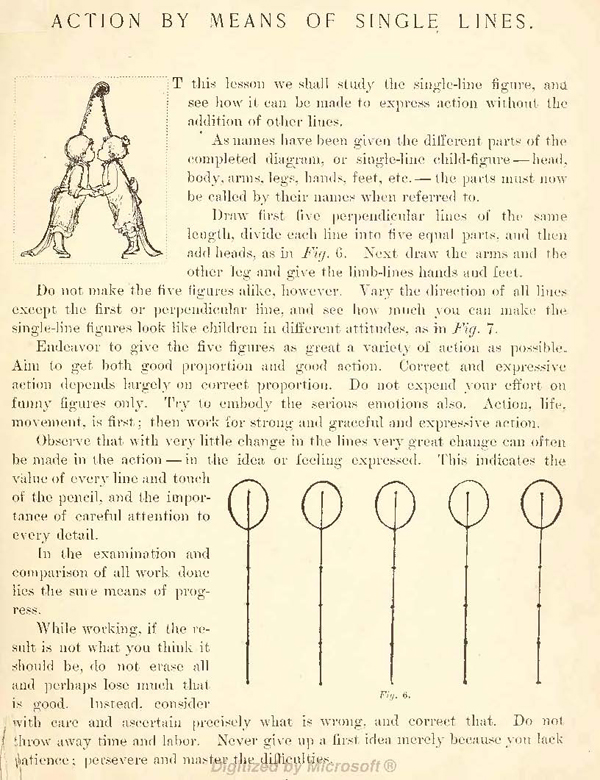Home > Directory of Drawing Lesson > Human Face > Figures in Motion > Actions by Means of Single Lines
drawing children and people in action & motion by means of easy, single lines
|





[The above words are pictures of text, below is the actual text if you need to copy a paragraph or two]
ACTION BY MEANS OF SINGLE LINES
The work at the start—the single-line child-figure is very simple, and there is danger that the pupil may become careless. and forget the guide. the imperative importance of right proportions, and make one leg long and the other short, or both legs longer than the body. In drawing trees and rocks it would do to have a change from the nature-study in the length of lines here and there, because in landscape there is no exact relation in size of rock to hill or flower to tree, but in the human figure there is a definite relation in size of arm to body, in foot to leg. The work will be incorrect and unsatisfying if the law of proportion is not remembered and observed, and all the work done with care.
It is well to have a slate or blackboard on the wall for practice work. As You draw, be your own critic. by walking off and taking a view of the lines from a distance, where the real relation of one part to another. Go back and forth and correct by adding or erasing lines until you feel you have reached the best you can do.
After this nod work of self-criticism, sit down and copy the final result for preservation. Proceed in this way with all the lessons. and you will have an interesting and permanent record of the progress you have made. A portfolio of such drawings will be very serviceable.
I would speak again of the value of my seemingly simple directions. By standiing at some distance from the blackboard one takes a comprehensive view of one's work : whereas. sitting cramped over a bit of paper on the lap. one is apt, to give undue attention to parts and details. and therefore not see the real proportions and relations as a whole.
Study everything at Nvhich you look in a large. free way: consider the whole as veil as the detail. and the meaning behind it all. Try to look at what you arc dOillp' as if it were the work of another. See frankly both the good and h in it. It needs, and make it hard to practice work I would further say — in connection with these and exercises — set apart a time each day in which to work seriously at measuring (by the eye only) certain objects or parts of objects, and note in however simple a form the decision in 9, sketch on paper. This is advised to heights and width drawing, for here bring about the habit of correct work is a particularly valuable cautious and exact.
As you discover failures in of exercise work with the pen correction of such imperfections.
Be acquainted with your errc kind of work which NVill unmista the room, for instance, and ask sent the height of a certain chin shorter the cricket than the pi perpendicular and that of anotlp of any object with its greatest observation by actual measure and better to cultivate the eye which is likely to make your whenever be fussy about the 1. make a clean straight or cure have in mind that which von -V is likely to take care of itself.




